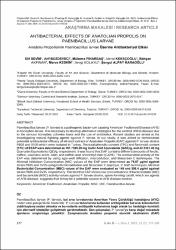Antibacterial effects of anatolian propolis on paenibacillus larvae

View/
Access
info:eu-repo/semantics/openAccessDate
2021Author
Sevim, ElifBozdevedi, Arif
Pınarbaş, Müberra
Kekeçoğlu, Meral
Akpınar, Rahşan
Keskin, Merve
Kolaylı, Sevgi
Karaoğlu, Şengül Alpay
Metadata
Show full item recordCitation
Sevim, E., Bozdeveci, A., Pınarbaş Çetin, M., Kekeçoğlu, M., Akpınar, R., Keskin, M., Kolaylı, S. & Alpay Karaoğlu, Ş. (2021).Antibacterial effects of anatolian propolis on paenibacillus larvae. Uludağ Arıcılık Dergisi, 21(2), 177-186.https://doi.org/10.31467/uluaricilik.976536Abstract
Paenibacillus larvae (P. larvae) is a pathogenic bacterium causing American Foulbrood Disease (AFB) in honeybee larvae. It is necessary to develop alternative strategies for the control of this disease due to the serious honeybee colonies loses and the use of antibiotics. Recent studies are aimed at the investigating natural fighting agents against P. larvae. In our study, it was aimed to demonstrate potential antibacterial efficacy of ethanol extract of Anatolian Propolis (EAP) against P. larvae strains PB35 and SV35 which were isolated in Turkey. The total phenolic content (TPC) and flavonoid content (TFC) of EEAP were determined as 181.73±5.20 mg Gallic Acid Equivalents (GAE)/g, and 42.33±1.40 mg Quercetin Equivalents (QE)/g, respectively. It was found that EAP contains different amounts of ferulic, caffeic, coumaric acids, rutin, and caffeic acid phenethyl ester (CAPE). The antibacterial activity of the EAP was determined by using agar-well diffusion, microdilution, and Bioscreen C techniques. The Minimal Inhibition Concentration (MIC) values of the EAP were determined as 74.87 μg/ml against strain PB35 and SV35 using both microdilution and Bioscreen C teqnique. In both techniques, Minimal Bactericidal Concentration (MBC) values of the EAP were evaluated as 149 and 598.4 μg/ml against strain PB35 and SV35, respectively. The fact that EAP shows low concentrations of bacteriostatic (MIC) and bactericide (MBC) activity values against P. larvae strains, spore-forming bacilli, which are agents of AFB disease, suggests that it may be a potential source in AFB disease control.

















